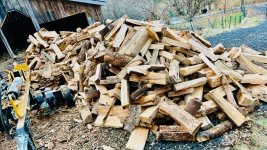I've owned them both and am currently using a commercial grade Super Split. My previous splitter was commercial grade hydraulic with a high flow rate pump (fast cycle speed... for a hydraulic). A few thoughts regarding your questions:
1. The kinetic unit is not "scary" at all. It is faster on the splitting stroke (not "scary" fast), but where it gets most of it's speed advantage is on the return stroke, which does not present any danger of crushed fingers, etc.
2. The kinetic splitters are very productive in comparison to hydro splitters, provided that you have a high enough "feed rate". With a single operator, you lose most of this advantage. I've found that a three person team is about perfect in maximizing the output capability of my kinetic.
3. If you don't have a higher throughput objective (1-2 cords/year is very modest production), hydraulic is the way to go as a good kinetic splitter is a lot more expensive than non-commercial hydros.
4. If you want electric, kinetics like the Super Split can be ordered with electric motors for a nice, quiet and exhaust free splitting experience. The nature of the beast lends itself well to electric power. I've seen a few electric standard hydro units (I think they all started life as standard hydro units) and they were terminally slow even with their 220 motors (I don't know the size of the motors). I'm aware of some light duty electric models out there that are easily portable, have limited "oomph" and are super slow but if your volumes are limited, your wood is easily split with relatively few knots they are inexpensive and might just do the trick.
5. I have not found any great need for maintenance on either kinetics or hydros. Change oil in the motor regularly, adjust slides once in a great while and occasionally grease the slides and keep fresh gas in it and you're good to go. Close to anvil-like reliability if you do that and for 1-2 cords/year just use non-ethanol gas and keep stabilizer in it. It is nice to have a unit with a good air filter and hydro filter, but that's not necessary by any means.
6. Personally, I find the kinetic far superior (for my needs.. and budget was not a constraint).. I like the speed and find it more interesting to use (yes, I am easily amused). I haven't found the round that it won't split although once in a while it might take a couple of hits to split it (I have large flywheels and a geared motor on mine though). My hydro unit never needed 2 cycles as the pump would "shift into low" when it started bogging and it'd shear anything that I ever put in its way (yes, I found that interesting too ;-)).
For the price and what you've described as your needs, I'd get a lower-end gas powered hydro (like a 18-22 ton) unit from one of the big boxes and be done with it.
YMMV

